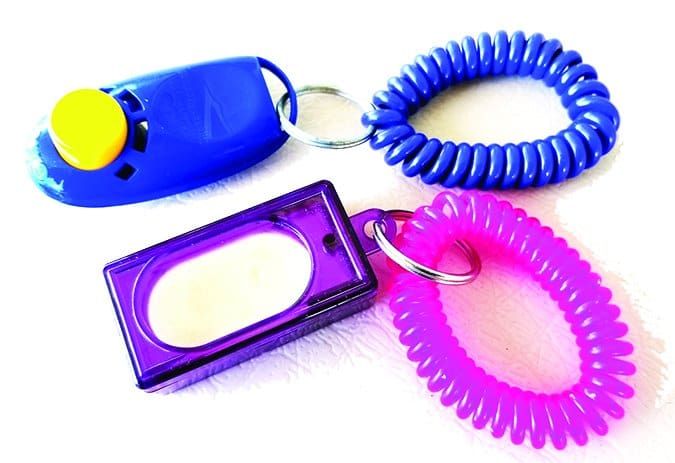Unless you’ve been living in a cave for the past 20 years, you’ve probably heard of clicker training. Chances are good you’ve seen it, and maybe even done it yourself. But on the off chance you haven’t, or in case you have but still aren’t sure what it’s really about, read on.
In 1984, dolphin trainer Karen Pryor published a small book titled Don’t Shoot the Dog. A small book – but it was destined to accomplish big things. Although intended to address human interactions – to teach people how to use positive reinforcement to change the behavior of other humans – the book was seized upon by the dog-training world (no doubt due to the title) and soon a seismic shift was under way for the Rin Tin Tins and Lassies of the world.
In the book, Pryor described how a clicker or other conditioned reinforcer could be used to accelerate learning. Dog trainers (in particular) found the methods Pryor described to be easy, fun, and successful; over time, the phrase “clicker training” became a popular slang term for positive reinforcement training that uses a “reward marker” of some sort, and the clicker became the method’s emblem.
Clickers Work Because They Provide A Consistent Signal
A reward marker is a reproducible signal that indicates to the training subject that she has just earned a reward of some sort. The reward marker doesn’t have to be a clicker; it can be any consistent sound, word, or even a gesture that always means a reward is coming.
The reward marker also serves another purpose: It bridges the time gap between the subject’s behavior and the delivery of the reinforcing reward. It might take only a second or two to deliver a treat to your dog’s lips when he sits in front of you and you have clicked a clicker, but if you are teaching him to turn on a light switch that is across the room, the click of the clicker (or other reward marker) lets him know that flipping the light switch was the behavior that has earned him a reward, which he will enjoy as soon as you go to him or he returns to you!
The secret to the clicker (or any other marker) is this: When beginning training, the marker is paired with a high-value reinforcer (most frequently a food treat) until the dog has made a classically conditioned association between the sound and the treat.
If you use a clicker as your marker, you would create this association initially by clicking the clicker and then immediately feeding the dog a treat. You repeat this a number of times – click, treat; click, treat; click, treat – until your dog’s eyes light up when she hears the click and she looks for the treat. We sometimes refer to this process as “charging” the clicker; we’ve given the click significance, and the dog understands that the click means a reward is coming.
Your Dog Training Reward Markers Doesn’t Need to “Click”
A clicker is a small device that makes a consistent, discrete clicking sound. Some make a very sharp sound; some make a softer (though still consistent) clicking sound, like the sound of a ballpoint pen being retracted or extended with the press of a button. But markers don’t have to be a click; any distinctive, consistent sound, gesture, or event can work.
I sometimes use the verbal marker “Yes!” with dogs, in a distinct, consistent, bright tone of voice (so it doesn’t get confused with a “yes” spoken in casual conversation). I have also perfected a loud “mouth click” by suctioning my tongue to the roof of my mouth and pulling it off with a resounding “pop” – very useful when working with horses and I want both of my hands free to handle a 1,000-pound animal and related equipment. (Yes, you can clicker train horses, cats, pigs, chickens, fish – just about any animal with a central nervous system.) In fact, dogs who are sound-sensitive may do better with a verbal marker than a plastic clicker.
But the marker doesn’t have to be a sound! People who train deaf dogs often use a thumbs-up gesture or a momentary flash of a small flashlight to mark the desired behavior displayed by their canine students. Any signal that is consistent and easily noticed can work as a reward marker.
Charging a Clicker for Dog Training
Once you have charged your clicker, you are ready to begin training with it. Now you cue, prompt, lure, or just wait for the dog to perform a certain behavior. The instant that the behavior happens, you click and immediately feed her a treat. After you do this several times, you will see that your dog will quickly come to understand that whatever she was doing when she heard the click is what made the click happen and the food appear. She will also quickly realize that chances are good that if she displays that behavior again, she’ll get clicked and treated again.
By the way – you do not have to click to reinforce every behavior. Remember that the purpose of the click is to bridge the gap in time between the behavior and the treat, so the dog knows what behavior is being reinforced. Technically, if you are close enough to the dog to deliver the treat immediately after she does the behavior, you don’t have to click first. But most “clicker trainers” will testify that the use of a discrete signal seems to help most animals quickly discern and deliver the desired behavior.
The whole premise behind positive reinforcement-based training is that behaviors that are reinforced repeat or increase, and behaviors that are not reinforced extinguish. So, if we are good at reinforcing the behaviors we do want, and preventing reinforcement for behaviors we don’t want (management!), we end up with a dog who chooses to do behaviors that we like.
The last step in this type of training is to add cues. A cue invites the dog to do the desired behavior, the marker tells her when she’s done it, the reward reinforces it, and voila! Your training is well under way. If you do this process well, punishment, pain, and coercion are totally unnecessary for a successful training program.
Use the Clicker for Training, Not Forever
Does this mean you will always need to click and treat your dog for doing any desirable behavior for the rest of her life? Not at all. You do need to provide prompt reinforcement if you use a reward marker; your marker is a promise that a reinforcer is coming. In fact, there are studies now that suggest using a marker without a reward (a click, but no treat) can cause your dog’s response to deteriorate pretty quickly.
But you can put behaviors on a variable schedule of reinforcement (gradually!), so your dog comes to know that eventually a marker and reward will happen. “Lassie, sit! Good girl! … Lassie, sit! Good girl! … Lassie, sit!” Click, treat. Like a gambler at a slot machine, if you vary the reinforcement schedule, your dog will keep playing the training game, waiting for it to pay off. But note this: If you get too stingy or reduce reinforcement too quickly, your dog may well quit playing, just as you might if you were sitting at a slot machine that only rarely gave you a small reward.
There are now clicker trainers in practically every community in the United States. If you’re looking to give it a try and want some help, seek one out. There are also many books and websites that can guide you in your clicker training journey. Ready, set…click!
Clicker Training Resources
Here are some resources to get you started on your clicker journey:
Books
The Power of Positive Dog Training, by Pat Miller
Clicker Training for Dogs, by Karen Pryor
The Thinking Dog: Crossover to Clicker Training, by Gail Fisher
DVDs
“Basic Good Manners” by Pat Miller
“Clicker Puppy” by Doggone Crazy
YouTube
Search for “clicker training” on Youtube.com; you will find many great examples. We strongly recommend the videos by trainer Emily Larlham.
Trainers
Look for trainer referrals at the Pet Professional Guild. They may not all be clicker trainers but they are all committed to force-free training, so most of them will be.
Clickers
Most pet-supply stores now carry clickers, as do your friendly neighborhood clicker trainers. You can find them easily online as well. In general, the box clickers are louder; the button clickers make a softer sound.







Hi,
I loved your article. I have almost 2 years old standard poodle he is very playful and curious poodle. But he barks and gets uncontrollable when he sees another dog across the street or away I’m the distance. I need some advice regarding this as I’m worried he is getting stronger and worried if his behavior gets aggressive.
Try snapping him out of barking by lightly tapping him with your foot. when you let your dog pull on the leash you are showing him that there is something to be angry or excited about so try your best to release that tension. Because that could be causing the barking . Hope you figure it out!!!!!! -Bronwyn Sterling
Thanks for your tips, it will help me a lot.